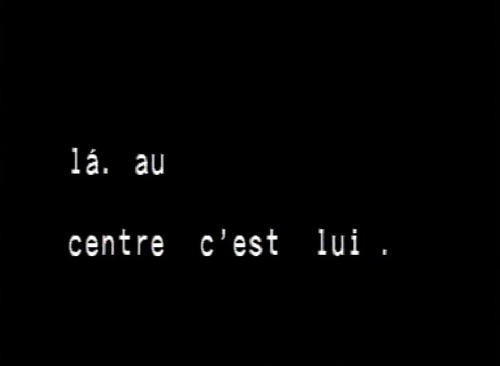casting the Credits
Isidore Gracián :
Your films are made up of music, stories, paintings, written or spoken literary texts, but they never end with conventional credits, specifying the names of authors, composers and actors. Instead there are lists of unintelligible initials, names of people, dates or places with no obvious connection to the film. Why?
Jean Seban :
Credits classifying functions and locations are a series of violent deeds carried out against the irreducibility and the mystery of our Now; this is the exact reproduction of a predetermined hierarchy of film-work on behalf of an illusory "respect for others", a respect which by naming and assigning places forgets the infinite worlds intrinsic to each individual. In order to go towards the other, why not propose a motion that questions him before defining him and promising an identity? You're not DoP as, indeed, a birdsong passes through your pictures, you're not the director because you're not even able to identify who haunts you, you're not a lead composer because the intermission popcorn pops over your adagio, you're not a spectator because every time you create the very sounds and images you are watching, you're not the movie theater because in the depths of the screen you can sense the city and the sea beyond it.
It is uncanny that when reading obituaries, no one bows down before the list of diplomas and the prestigious responsibilities of these dead men. On the grave all ranks and honors quiver, whereas the epitaph of a common dead man is brought to life by a single word from his wife or his children. One could even say that the list of honors is like a shovelful of earth which covers the end of a man with its muffled laughter while a few words provide the key to the tomb, the key to exit it. Thus, a word, a name or two initials lost in the list of credits reflect an unsteady, insignificant position, and under the seal of humility, the tale will indefinitely repeat itself and each name in tune with the cohort of animals in Noah's Ark, will appear and rise without the need for an ephemeral hierarchy.
Nevertheless, in the first 3 films, Chamfort Information, Le Mascaret, Véra, there were credits with a function and some honorary classification, but it brought a discrepancy with the film itself; then following Godard’s path, especially with his film Vivre sa Vie, I tried to compose a long parallel list, a huge block of text with all participants side by side, and I kept the two variants in these films. Then including the classic credits became pointless. In L’Amitié for instance, the credits are limited to a list of initials for people who took part in the film or shadows: how to talk about Jean-Pierre Klein, my dead friend, about the trouble of his absence negated by the excessive presence of the name of others? Paradoxically, I would have liked to remove his name to give him his due place. In the movie Saint Julien L'Hospitalier, "The Art of Fugue" by Bach is a film character, likewise, some characters embody musical movements; the distinction of positions was already completely abolished in Flaubert’s legend, itself inspired by another text: La légende dorée by Jacques de Voragine and a stained glass window in the Cathedral of Rouen.
The list with no apparent hierarchy encourages us to read the text not as respectful and protocolary credits but rather as a trail to follow so as to better appreciate what we have seen; it consists of the living matter of the film. If names which at first glance have nothing to do with the film appear in the credits, it is because the film-work – its wandering – has been crossed by and speaks for and with those missing. The mere shift from one name to another, a name that would not be linked to the other through function, hierarchy, privileged position but though an "and" that accumulates and reveals the treasures of what Spinoza describes as a unique Nature, the same matter organized around some different attributes: the Cliffs at Varengeville and the Goldberg Variations and August 4, 2013 and now, and Jean-Pierre Klein and …
Starting with the credits, in a film every sound and every image participate in the coherence of a writing style. The purpose is not to craft a paradox, to print onto the credits a kind of manifesto but to establish from the first frame another relationship with the viewer introducing him to the abundant substance of the film. Ideally there would not showcasing box with a film inside but a single song.

Credits of l'amitié (1993, 47 min)
déchiffrage
films




Flagrant délit de




















